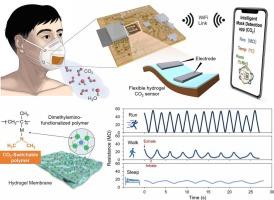Humidity-compatible chemiresistive hydrogel sensor for real-time breath CO2 monitoring
IF 13.2
1区 工程技术
Q1 ENGINEERING, CHEMICAL
引用次数: 0
Abstract
Real-time monitoring of exhaled carbon dioxide (CO2) is essential for assessing metabolic status and tracking disease progression. However, the high moisture content of exhaled breath poses a significant challenge to the accuracy and stability of CO2 detection. Here, we present a flexible chemiresistive CO2 sensor based on a dimethylamine-functionalized hydrogel, in which water molecules critically facilitate the CO2-induced reversible protonation of tertiary amine groups, thereby modulating the hydrogel's ionic conductivity for real-time breath analysis. As a result, the hydrogel synthesized from N-[3-(dimethylamino) propyl] methacrylamide (DMAPMA) exhibits a high CO2 response of 37.3 % at 10,000 ppm and a low detection limit of 100 ppm. To further enhance mechanical durability under respiratory-induced stress, N,N-Dimethylacrylamide (DMAA) was incorporated into the hydrogel, increasing the tensile strain limit from 34.2 % to 51.0 % without compromising CO2 sensing performance. In addition, we demonstrate the integration of the hydrogel sensor into a wireless smart mask system, enabling multimodal monitoring of respiratory CO2 patterns, physical activity, and postprandial metabolic changes. This platform offers a scalable, low-power solution for wearable CO2 sensing in personalized health monitoring.

湿度兼容的化学水凝胶传感器,用于实时呼吸二氧化碳监测
实时监测呼出的二氧化碳(CO2)对于评估代谢状态和跟踪疾病进展至关重要。然而,呼出气体的高水分含量对CO2检测的准确性和稳定性提出了重大挑战。在这里,我们提出了一种基于二甲胺功能化水凝胶的柔性化学电阻CO2传感器,其中水分子关键地促进二氧化碳诱导的叔胺基团的可逆质子化,从而调节水凝胶的离子电导率,用于实时呼吸分析。结果表明,由N-[3-(二甲氨基)丙基]甲基丙烯酰胺(DMAPMA)合成的水凝胶在10,000 ppm下具有37.3 %的高CO2响应和100 ppm的低检出限。为了进一步提高呼吸诱导应力下的机械耐久性,将N,N-二甲基丙烯酰胺(DMAA)掺入水凝胶中,在不影响二氧化碳传感性能的情况下,将拉伸应变极限从34.2% %提高到51.0% %。此外,我们还演示了将水凝胶传感器集成到无线智能面罩系统中,实现呼吸CO2模式、身体活动和餐后代谢变化的多模式监测。该平台为个性化健康监测中的可穿戴式二氧化碳传感提供了可扩展的低功耗解决方案。
本文章由计算机程序翻译,如有差异,请以英文原文为准。
求助全文
约1分钟内获得全文
求助全文
来源期刊

Chemical Engineering Journal
工程技术-工程:化工
CiteScore
21.70
自引率
9.30%
发文量
6781
审稿时长
2.4 months
期刊介绍:
The Chemical Engineering Journal is an international research journal that invites contributions of original and novel fundamental research. It aims to provide an international platform for presenting original fundamental research, interpretative reviews, and discussions on new developments in chemical engineering. The journal welcomes papers that describe novel theory and its practical application, as well as those that demonstrate the transfer of techniques from other disciplines. It also welcomes reports on carefully conducted experimental work that is soundly interpreted. The main focus of the journal is on original and rigorous research results that have broad significance. The Catalysis section within the Chemical Engineering Journal focuses specifically on Experimental and Theoretical studies in the fields of heterogeneous catalysis, molecular catalysis, and biocatalysis. These studies have industrial impact on various sectors such as chemicals, energy, materials, foods, healthcare, and environmental protection.
 求助内容:
求助内容: 应助结果提醒方式:
应助结果提醒方式:


